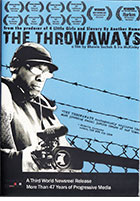
The Throwaways 2014
Distributed by Third World Newsreel, 545 Eighth Avenue, Suite 550, New York, NY 10018; 212-947-9277
Produced by Ira McKinley, Adele Pham, Messiah Rhodes, Bhawin Suchak
Directed by Ira McKinley, Bhawin Suchak
DVD, color, 62 min.
College - General Adult
African Americans, Homelessness, Law Enforcement, Poverty, Racism, Social Problems
Date Entered: 05/05/2016
Reviewed by Wendy Highby, University of Northern ColoradoThe Throwaways exposes the systemic nature of the social problems of destitute African Americans, particularly those who have been incarcerated. It presents ex-convict Ira McKinley in a dual role as co-director and subject. He and his neighborhood in Albany, New York, serve as a case study of the permanent underclass. The film examines how difficult it is to escape the entrenched United States system of mass incarceration and the pervasive cycle of poverty it engenders. Following his release from prison, Ira received training in film editing and production at Northampton Community Television (in Massachusetts). He is intent upon using the camera as an activist’s tool to help his community by documenting his own experience of chronic homelessness and unemployment and the decimation of his inner-city neighborhood.
The tone of the film is unique; from the outset, it grabs the viewer by the lapels with its grittiness and urgency. Audacious in its approach, it tests its relationship with the audience, questioning how we filter our view of the world. It does this quite artfully by beginning the narrative with a quote from Ralph Ellison’s Invisible Man—“I am an invisible man. I am a man of substance, of flesh and bone, fiber and liquids—and I might even be said to possess a mind. I am invisible, simply because people refuse to see me” [emphasis added]. We are put on notice from the first frame. The Throwaways assigns an active role to viewers, giving us responsibility: by refusing to see humanity in our fellow human beings, we become complicit in continuing the harmful cycle.
Ira serves as a relatable, compelling guide to his blighted Albany neighborhood and the broken system. His father was killed by the police when he was a boy. He suffers from post-traumatic stress disorder (PTSD) as a result and has trouble controlling his high blood pressure. As a young man he was addicted to crack and became a felon to support his habit. Having served his time, he is frustrated by his entrapment in a cycle of unemployment and homelessness. He is shut out of employment opportunities because of his ex-felon status, and many jobs don’t provide a living wage. The film is well-edited, featuring a good balance of Ira’s personal experience, interviews with people in the neighborhood, press conference footage, and academic experts. In one of several candid sidewalk interviews, a man points out that spending priorities in the United States are skewed toward fighting wars and foreign aid. Ira discusses the lack of social services, giving the example of draconian rules regarding food stamp eligibility that exclude ex-convicts. The film tackles the issues of police brutality and police-community relations. Particularly moving is the footage of a press conference held soon after the police shooting of NahCream Moore, an African American man; it captures the raw emotions within the community. Ira interviews Van Jones, former Special Advisor for Green Jobs in the Obama administration. Jones explains that there are no throwaways in his concept of environmentalism; human rights and ecology are intertwined, and you must stand up for both planet and people.
The film is highly influenced by the thesis of Michelle Alexander’s book The New Jim Crow: Mass Incarceration in the Age of Colorblindness (2010). She describes her view of the “New Jim Crow” system to Ira: “The system of mass incarceration itself stems from an effort to divide . . . poor people along racial lines . . . the get-tough movement and the war on drugs was part of a deliberate strategy . . . pollsters and political strategists found that get tough rhetoric on issues of crime and welfare could appeal to poor and working class whites and pit poor and working class whites against poor folks of color--and that’s ultimately what The Throwaways is all about, right? Groups of people who are defined as different enough that you don’t have to care . . . and [they] can just be thrown away.”
Ostensibly, The Throwaways is about the life of Ira McKinley and his activism and caring for his community. But on another level, it is about the viewer. The film culminates with a challenge to the audience. Breaking the fourth wall, Ira explains, “I never thought I was a throwaway; you thought I was something you could throw away.” Thus the film has circled back to Ellison’s Invisible Man, who rises from the refuse, channeled by Ira, and confronts the viewer. Ira’s insistence upon visibility and his refusal to internalize the systemic racism makes him a powerful role model of assertive movement toward healing and reconciliation.
The Throwaways is a fine film for use in college courses, particularly apt for African American studies and race theory courses, as well as curricula in sociology, criminal justice, political science, public policy, social work, and psychology. Professors will need to supplement this case study and its indictment of the system with some additional contextual material, such as statistics that extrapolate from Ira’s experience, evaluative information about social services programs, and alternative policy ideas. Viewers of any political persuasion will find enlightenment here; some will find support for changing public policy, and others can use the film as a debate starter. But no one, in good conscience, can use Ira McKinley as a straw man, because we have been given the opportunity to see Ira’s experience. He and co-director Bhawin Suchak have exposed the cyclical path from willful neglect and racism to mass incarceration and entrenched poverty. The Throwaways presents a sincere and heartfelt argument for the need to mobilize social movements to reform our broken systems.